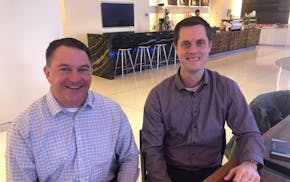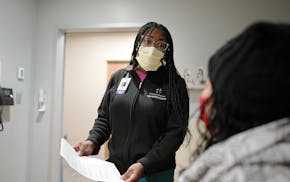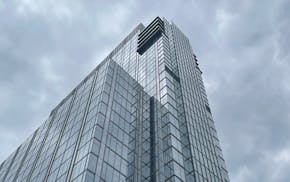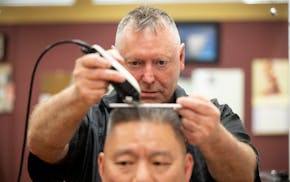Deb Hilmerson has been breaking barriers since she broke into the construction trade after college in 1989.
The daughter of a Little Falls, Minn., auto salvage-yard owner, she already knew something about getting her hands dirty, cannibalizing parts for sale and crushing what was left.
After graduating from the University of Minnesota, where she was captain of the women's basketball team, she called a basketball fan who was an executive of the former Hanson Spancrete in Osseo. It took a while to convince him to hire her as a laborer trainee, not an office assistant.
By the early 1990s, Hilmerson was setting precast concrete and representing Spancrete in safety meetings during construction of the Mall of America. She subsequently was hired by Mortenson Construction and sent as safety director to the construction site of a $220 million wastewater treatment plant in Seattle.
Hilmerson struck out on her own in 2001, forming Hilmerson Safety, consulting and on-site inspections for companies such as NRG, 3M, Mortenson, BP and Chevron. They increasingly bought into the economical notion that investing in safety and preventing accidents avoids injuries, deaths and huge related costs.
"But safety is a risky business," Hilmerson said. "The contractors didn't always take my advice. Some saw me as someone who would just leave them with a list of noncompliant items and corrective actions to do. I wanted to add more value."
By 2016, Hilmerson was planning to replace her consulting business, for the most part, with a construction-products business built around safety and reuse. It had something of an inauspicious start.
"I started by creating a 'current cover' product for outlets that often were still energized during construction projects, after the cover plates had been removed," she recalled.
Hilmerson was auditing contractors who were plugging into the outlets where live wires were exposed.
"You can't do that according to OSHA rules, and I didn't have a solution," Hilmerson recalled. "I went to Home Depot and looked at outlet covers. We made a little cover that protected the small area where there was exposure to touch or a screwdriver. It allowed the workers to continue their job without electrical exposure.
"A pack of 50 costs $39, compared to an OSHA violation that can cost thousands of dollars. But I'd have to sell about 16 million of those to get my money back. And I only have so much time in the day," she said.
The next two products have proved more lucrative. They are Hilmerson-conceived, American-made construction site safety products that should approach $5 million in sales this year, close to double from last year's. That's less than originally envisioned because of the COVID-19 recession.
In 2017, Mortenson, after two-plus years and $100,000-plus in research and development by Hilmerson, pioneered a reusable construction rail on the Allianz Field soccer stadium in St. Paul that replaced wood two-by-fours. Falls are the No. 1 cause of injury and death on building sites.
"Two-by-fours are wasteful, time consuming to build and only as good as the carpenter who builds them," Hilmerson said. "You never lean on a 2-by-4 guardrail because you can't rely on them."
Mortenson, JE Dunn Construction and other contractors also use Hilmerson's steel rail system. It exceeds OSHA standards and is easy to install and reuse.
Hilmerson estimated she has sold 265,500 linear feet of safety railing, enough to save about 50 miles' worth of 2-by-4 lumber, which usually is discarded after a project. She plants a tree in the name of a customer in a national forest for every 10-foot guardrail panel sold.
The Hilmerson barrier fence system upgrades traditional top-mounted fencing on concrete barriers around construction sites to protect pedestrians, traffic and workers.
Hilmerson patented a "sidesaddle bracket" that's bolted to the barriers into which the reusable, steel fences are mounted. They are now in use downtown at the U.S. Bank Stadium LRT station and the Minneapolis public-service building that's being built on Fourth Avenue.
The barrier-fence system precludes the damage that occurred to old fences that were bolted directly to concrete barriers. The new system is safer, sturdier and the fences are 2 feet higher, said Rich Bistodeau, a retired Mortenson site superintendent who has known Hilmerson for years.
"The old way, using quick bolts drilled into concrete barriers, the first time somebody bumps it with a truck or forklift, the bolts would break off," Bistodeau said. "Or a contractor would just use fence posts secured with sandbags. Her barrier fences are a lot sturdier and faster to install.
"Deb has ambition, a good drive and an entrepreneurial spirit. She's a leader. She always wanted to fix things. If you put her in a room with five or six, an hour later, she'll be leading the discussion. I met her when she was our safety director. She wanted jobs done right and she could always present in a nonintimidating way."
Hilmerson said both products have proved cash-flow positive over the last couple years. And she finds running a safety products outfit more rewarding than safety consulting.
"They solve problems that affect every job site in America," Hilmerson said. "It allows workers to be safer and more efficient. It saves time and money. With safety consulting, I could only impact people on that job site."
Neal St. Anthony has been a Star Tribune business columnist and reporter since 1984. He can be contacted at nstanthony@startribune.com.

St. Anthony: 'Patient' investing paying off for St. Paul's Hill Capital

Jennifer Smith, leader of Burnsville's Innovative Office Solutions, has died

St. Anthony: Medical professions in Minnesota need more people of color in their ranks


